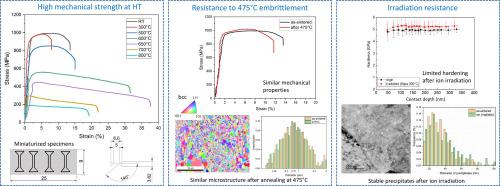Mechanical properties, 475°C embrittlement and irradiation resistance of FeCrAl-Y2O3 ODS alloy with Ti and V alloying additions
IF 3.2
2区 工程技术
Q3 MATERIALS SCIENCE, MULTIDISCIPLINARY
引用次数: 0
Abstract
FeCrAl-based ODS alloys are promising for Generation IV nuclear reactor components since they present remarkable properties, such as high mechanical strength and good irradiation resistance. However, there is still relatively little information on the impact of minor alloying elements, e.g., Ti or V, and manufacturing conditions on the properties of these alloys. In this paper, two FeCrAl-based alloys with the minor addition of Y2O3, Ti, and V were studied. The investigation focuses on the mechanical properties at high temperatures (up to 800 °C), resistance to so-called “475 °C embrittlement” (α and α’ phase separation), and irradiation resistance. The conducted tensile tests show promising mechanical properties at room temperature, i.e., the yield strength is 893±23 MPa, and the ultimate tensile strength is 993±10 MPa. The tensile tests at high temperatures also confirm good properties, e.g., at 600 °C the yield strength is 490±8 MPa, the ultimate tensile strength is 526±14 MPa, while the total elongation is 17±4 %. The results reveal that adding vanadium increases the strength of the FeCrAl ODS alloys. The conducted annealing at 475 °C for 1000 h shows limited hardening and almost no change in elongation of the alloy with the addition of vanadium. The performed ion irradiation experiments show good irradiation resistance of both tested alloys, manifesting by limited hardening and stable oxide precipitates. The results confirm the promising properties of studied materials for application in the nuclear industry, particularly in Generation IV reactors. Moreover, the results show the possibility of tuning properties by adding alloying elements, such as vanadium.

添加Ti和V合金的feral - y2o3 ODS合金的力学性能、475℃脆性和耐辐照性能
铁铁基ODS合金具有机械强度高、耐辐照性能好等显著性能,有望用于第四代核反应堆部件。然而,关于少量合金元素,如Ti或V,以及制造条件对这些合金性能的影响的信息仍然相对较少。本文研究了少量添加Y2O3、Ti和V的两种feral基合金。研究重点是高温(高达800°C)下的力学性能,抗所谓的“475°C脆化”(α和α '相分离)和耐辐照性。拉伸试验结果表明,该材料的室温屈服强度为893±23 MPa,极限拉伸强度为993±10 MPa。高温拉伸试验也证实了其良好的性能,在600℃时屈服强度为490±8 MPa,极限抗拉强度为526±14 MPa,总伸长率为17±4%。结果表明,钒的加入提高了feral ODS合金的强度。在475℃下退火1000 h,合金的硬化程度有限,并且随着钒的加入,合金的延伸率几乎没有变化。离子辐照实验表明,两种合金均具有良好的抗辐照性能,表现为硬化有限,氧化物沉淀稳定。研究结果证实了所研究材料在核工业,特别是第四代反应堆中的应用前景。此外,结果表明,通过添加合金元素,如钒,可以调整性能。
本文章由计算机程序翻译,如有差异,请以英文原文为准。
求助全文
约1分钟内获得全文
求助全文
来源期刊

Journal of Nuclear Materials
工程技术-材料科学:综合
CiteScore
5.70
自引率
25.80%
发文量
601
审稿时长
63 days
期刊介绍:
The Journal of Nuclear Materials publishes high quality papers in materials research for nuclear applications, primarily fission reactors, fusion reactors, and similar environments including radiation areas of charged particle accelerators. Both original research and critical review papers covering experimental, theoretical, and computational aspects of either fundamental or applied nature are welcome.
The breadth of the field is such that a wide range of processes and properties in the field of materials science and engineering is of interest to the readership, spanning atom-scale processes, microstructures, thermodynamics, mechanical properties, physical properties, and corrosion, for example.
Topics covered by JNM
Fission reactor materials, including fuels, cladding, core structures, pressure vessels, coolant interactions with materials, moderator and control components, fission product behavior.
Materials aspects of the entire fuel cycle.
Materials aspects of the actinides and their compounds.
Performance of nuclear waste materials; materials aspects of the immobilization of wastes.
Fusion reactor materials, including first walls, blankets, insulators and magnets.
Neutron and charged particle radiation effects in materials, including defects, transmutations, microstructures, phase changes and macroscopic properties.
Interaction of plasmas, ion beams, electron beams and electromagnetic radiation with materials relevant to nuclear systems.
 求助内容:
求助内容: 应助结果提醒方式:
应助结果提醒方式:


